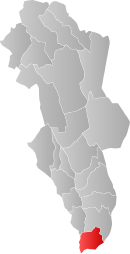Eidskog
| Eidskog kommune | |||
|---|---|---|---|
| Municipality | |||
 |
|||
|
|||
 Eidskog within Hedmark |
|||
| Coordinates: 59°59′53″N 12°3′38″E / 59.99806°N 12.06056°ECoordinates: 59°59′53″N 12°3′38″E / 59.99806°N 12.06056°E | |||
| Country | Norway | ||
| County | Hedmark | ||
| District | Glåmdal | ||
| Administrative centre | Skotterud | ||
| Government | |||
| • Mayor (2007) | Knut Gustav Woie (Sp) | ||
| Area | |||
| • Total | 641 km2 (247 sq mi) | ||
| • Land | 604 km2 (233 sq mi) | ||
| Area rank | 174 in Norway | ||
| Population (2004) | |||
| • Total | 6,431 | ||
| • Rank | 154 in Norway | ||
| • Density | 11/km2 (30/sq mi) | ||
| • Change (10 years) | -0.1 % | ||
| Demonym(s) | Eidskoging | ||
| Time zone | CET (UTC+1) | ||
| • Summer (DST) | CEST (UTC+2) | ||
| ISO 3166 code | NO-0420 | ||
| Official language form | Bokmål | ||
| Website | www |
||
|
|
|||
Eidskog is a municipality in Hedmark county, Norway. It is part of the traditional region of Glåmdal. The administrative centre of the municipality is the village of Skotterud. Eidskog was separated from the municipality of Vinger in 1864.
The municipality is located at the southern end of Hedmark county. It is bordered to the north by the municipality of Kongsvinger and in the west by Aurskog-Høland, Nes og Sør-Odal. Eidskog borders on Sweden, both to the east and south.
The Old Norse form of the name was Eiðaskógr. The first element is the plural genitive case of eið which means "path between two lakes". The last element is skógr which means "woods". Thus "the woods with the many eiðs". (In old times people travelled in small boats on the lakes and the rivers, but they had to drag the boats over the eids.)
The coat of arms is from modern times. It was granted on 12 September 1986. The arms show a gray background with a black grouse, a common inhabitant of the many forests in the municipality. Forestry is also one of the main sources of income in the area.
The name Eidskog is ancient and was used for the region between today’s Kongsvinger in Norway and Arvika in Sweden. Eskoleia, the route through Eidskog, was (and continues to be in the form of Riksvei 2) one of the most important traffic arteries between Norway and Sweden. The name was already in use during the saga period and became, after the canonization of Saint Olaf and important pilgrim’s route from Europe to Nidaros. At Midtskog (Norwegian: middle of the woods), today called Matrand, a stave church was raised in the 12th century. Today, Eidskog church is built on the same site and was constructed in 1665.
...
Wikipedia


